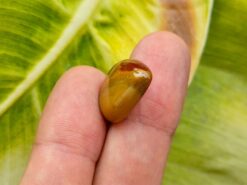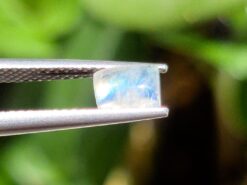Shungite

Shungite stone meaning and crystal metaphysical healing properties.
Buy natural gemstones in our shop
Shungite is a black, lustrous, non-crystalline mineraloid consisting of more than 98 weight percent of carbon. It was first described from a deposit near Shunga village, in Karelia, Russia, from where it gets its name. The stone has been reported to contain trace amounts of fullerenes (0.0001 < 0.001%).
Shungite stone meaning
The term “shungite” was originally used in 1879 to describe a mineraloid with more than 98 percent carbon. More recently the term has also been used to describe shungite bearing rocks, leading to some confusion. THe stone have also been classified purely on their carbon content, with shungite-1 having a carbon content in the range 98-100 weight percent and shungite-2, -3, -4 and -5 having contents in the ranges 35-80 percent, 20-35 percent, 10-20 percent and less than 10 percent, respectively. In a further classification, The rock is subdivided into bright, semi-bright, semi-dull and dull on the basis of their luster.
The crystal has two main modes of occurrence, disseminated within the host rock and as apparently mobilised material. Migrated shungite, which is bright stones, has been interpreted to represent migrated hydrocarbons and is found as either layer, layers or lenses near conformable with the host rock layering, or vein, which is found as cross-cutting veins. it may also occur as clasts within younger sedimentary rocks.
The gemstone has to date mainly been found in Russia. The main deposit is in the Lake Onega area of Karelia, at Zazhoginskoye, near Shunga, with another occurrence at Vozhmozero. Two other much smaller occurrences have been reported in Russia, one in Kamchatka in volcanic rocks and the other formed by the burning of spoil from a coal mine at high temperature in Chelyabinsk. Other occurrences have been described from Austria, India, Democratic Republic of Congo and Kazakhstan.
Formation
The stone has been regarded as an example of abiogenic petroleum formation, but its biological origin has now been confirmed. Non-migrated gems is found directly stratigraphically above deposits that were formed in a shallow water carbonate shelf to non-marine evaporitic environment. The shungite bearing sequence is thought to have been deposited during active rifting, consistent with the alkaline volcanic rocks that are found within the sequence. The organic-rich sediments were probably deposited in a brackish lagoonal setting. The concentration of carbon indicates elevated biological productivity levels, possibly due to high levels of nutrients available from interbedded volcanic material.
The stratified shungite-bearing deposits that retain sedimentary structures are interpreted as metamorphosed oil source rocks. Some diapiric mushroom-shaped structures have been identified, which are interpreted as possible mud volcanoes. Layer and vein varieties, and it filling vesicles and forming the matrix to breccias, are interpreted as migrated petroleum, now in the form of metamorphosed bitumen.
Origin
The stone deposit contains an estimated total carbon reserve of more than 250 gigatonnes. It is found within a sequence of Palaeoproterozoic metasedimentary and metavolcanic rocks that are preserved in a synform. The sequence is dated by a gabbro intrusion, which gives a date of 1980±27 Ma, and the underlying dolomites, which give an age of 2090±70 Ma. There are nine shungite-bearing layers within the Zaonezhskaya Formation, from the middle of the preserved sequence. Of these the thickest is layer six, which is also known as the “Productive horizon”, due to its concentration of rock deposits. Four main deposits are known from the area, the Shungskoe, Maksovo, Zazhogino and Nigozero deposits. The Shungskoe deposit is the most studied and is mainly mined out.
Shungite uses
The stone has been used as a folk medical treatment since the early 18th century. Peter the Great set up Russia’s first spa in Karelia to make use of the water purifying properties of gem, which he had himself experienced. He also instigated its use in providing purified water for the Russian army. The anti-bacterial properties of crystal have been confirmed by modern testing.
It has been used since the middle of the 18th century as a pigment for paint, and is currently sold under the names “carbon black” or “shungite natural black”.
In the 1970s, It was exploited in the production of an insulating material, known as shungisite. Shungisite is prepared by heating rocks with low concentrations to 1090–1130 °C and is used as a low density filler.
Shungite stone meaning and crystal metaphysical healing properties benefits
The following section is pseudo scientific and based on cultural beliefs.
These stones are believed to possess qualities that can enhance the health of your mind, body, and soul in various ways.
Shungite stone meaning and crystal metaphysical healing properties is an excellent grounding stone. Its high vibration helps to bring your spiritual body properties down into the physical plane so that you can better integrate cosmic wisdom and karmic lessons. the stone is a powerful cleanser and banishes things from your life that may be draining your energy.
Purifies water
Since ancient times, the gem has been used to purify water. This is due to its alleged activity against bacteria and viruses.
A 2018 study states that rough shungite can filter water by removing contaminants and organic substances like pesticides. A 2017 study also found that carbon from shungite can remove radioactive compounds from water.
Healing uses
If you’re struggling with stress, anxiety, or feeling overwhelmed, try wearing a piece of shungite jewelry. Any time you’re feeling overwhelmed, bring your attention to the place where the stone is making contact with your physical body, close your eyes, and focus on your breath. Breathe in for a count of four, hold for a count of four, and then exhale for a count of four. This deep, rhythmic breathing will bring you back to your center and will help create stillness in your mind.
FAQ
Does shungite have healing properties?
Shungite stone meaning and crystal metaphysical healing properties for physical purification and detoxification, its healing properties go deeper into the emotional and spiritual realms, allowing anyone who works with shungite to cleanse their energy field of harmful or unwanted energies.
Where should I put shungite in my house?
Place the stone next to your bed or under your pillow. Similarly, you may put the pyramid next to your monitor or microwave. Stick the vrystal plate on the back cover of your mobile phone. You can also wear the gem in the form of pendants and amulets.
Is it safe to wear shungite?
Wearing shungite will not only make chakra healing more powerful, but it will also neutralize the energy being released from a blocked or overactive chakra. Neutralizing the energy will allow you to safely practice chakra healing and restore balance to the root.
How can you tell if shungite is real?
The intensive black color is the first distinguishing sign of genuine stone. It often has infusions of brown, gray or golden colors. These are traces of other minerals such as pyrite, that are found in the same layer.
How do you cleanse your crystals?
Immerse your crystal in a water bath overnight, or hold it under cool running water for a few minutes. Salt water will also purify crystals. Use ocean water or a mixture made from 1-2 tablespoons of salt completely dissolved in 8 ounces of water. Rinse your crystal in clear water when done.
Natural gemstones for sale in our shop
We make custom made shungite crystal stone jewelry for sale as engagement rings, necklaces, stud earrings, bracelets, pendants… Please contact us for a quote.
















